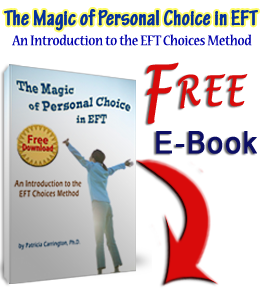Home » none » Combining Modern Meditation with EFT (Article)
Combining Modern Meditation with EFT (Article)
By Patricia Carrington
Recently, I met up with someone who was familiar with my training methods and writings on meditation, and who asked me, naively, “Why did you leave meditation for EFT? Do you think EFT is that much better?”
I was taken aback by this question. I have never stopped meditating since I first learned this method in the early 1970’s. I have never ceased to recommend it to others whom I think would benefit from it, and it remains an important resource in my practice as a clinical psychologist. However, EFT has now become the center of my therapeutic work. In fact, however, the two methods combine so naturally in my practice that I had scarcely noticed how much they do so until I was asked this question.
I want to share with you some information on how meditation, quite naturally and powerfully, can enhance the effects of EFT, and how it can substantially improve the results you may get when using it for yourself or with your clients if you are a therapist or life coach.
How the Two Methods Complement Each Other
In explaining the benefits that practicing a modern form of meditation can bring to your work with EFT, I am reminded of the oft-quoted saying by the Greek mathematician, Archimedes, "Give me a place to stand and I will move the world.” The emphasis in this statement is on a place to stand. The fact is that if we don’t have solid ground under our feet emotionally, then any technique we apply, whether it be a relaxation method, traditional psychotherapy, EFT, or any other intervention, suffers.
EFT practitioners are familiar with the phenomenon of working with a client and being able to help that person substantially reduce their stress over a certain issue, only to have them come back the next week simply overwhelmed by new issues. When this happens in my practice I am reminded of a child building a sand castle by the sea. As soon as they build the castle, the next wave comes in and washes it away. The child then rebuilds their castle, only to have the next wave wash it away again, and this happen repeatedly – it is an unending process. Similarly, while EFT is brilliantly effective, if in addition we add the solid continuing support that meditation can supply, EFT's staying power is magnified many times and we avoid the “child’s sand castle” effect.
I will not describe here the simplified modern form of meditation that I use with EFT (I do that in detail elsewhere on this site. I simply want to point out that modern forms of meditation such as, for example, Clinically Standardized Meditation (CSM), the modern meditation method I developed for the New York Telephone Company, are so permissive in nature and so easy to practice that they may be subjectively experienced as almost "effortless." Meditation of this sort is intrinsically pleasant and attracts the person to it. It is experienced more as a vacation from all cares once or twice a day than a chore or a "must."
To get back to the statement made by the person who mistakenly thought I had replaced meditation with EFT in my work– I have not done this. Instead I have combined the two in my professional practice and have found that the effects of this combination have been markedly more consistent and permanent than when I used either technique alone. The combination of EFT and Meditation is therefore what I advise when consulted for recommendations.
If you don’t happen to be familiar with the benefits of either Modern Meditation or EFT, or how they can be used with each other, I suggest you see my articles What is Meditation? and What is EFT? on this site. They contain essential information on this subject.


